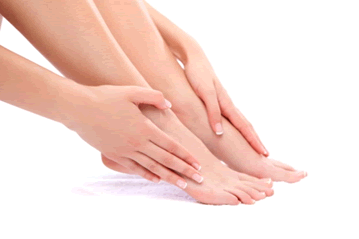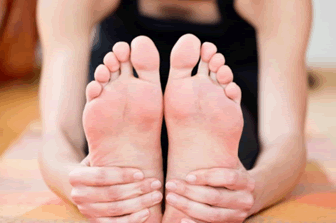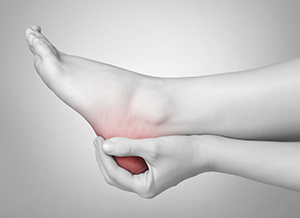
 Plantar fasciitis occurs when there is a strain or rupture of the long ligament that runs along the arch from the heel to the toe. Plantar fasciitis is one of the most common causes of heel pain. Symptoms can occur both after exercise and any time during daily activities. Wearing shoes that do not fit properly and exercising on hard surfaces such as turf or concrete may contribute to the development of plantar fasciitis. It can also be caused by a sudden increase in training intensity.
Plantar fasciitis occurs when there is a strain or rupture of the long ligament that runs along the arch from the heel to the toe. Plantar fasciitis is one of the most common causes of heel pain. Symptoms can occur both after exercise and any time during daily activities. Wearing shoes that do not fit properly and exercising on hard surfaces such as turf or concrete may contribute to the development of plantar fasciitis. It can also be caused by a sudden increase in training intensity.
Plantar fasciitis can be very painful and inconvenient. If you are experiencing heel pain or symptoms of plantar fasciitis, contact Dr. Robert Hope from Riverside Podiatry. Dr. Hope can provide the care you need to keep you pain-free and on your feet.
What is Plantar Fasciitis?
Plantar fasciitis is the inflammation of the thick band of tissue that runs along the bottom of your foot, known as the plantar fascia, and causes mild to severe heel pain.
What Causes Plantar Fasciitis?
· Excessive running
· Non-supportive shoes
· Overpronation
· Repeated stretching and tearing of the plantar fascia
How Can It Be Treated?
· Conservative measures – anti-inflammatories, ice packs, stretching exercises, physical therapy, orthotic devices
· Shockwave therapy – sound waves are sent to the affected area to facilitate healing and are usually used for chronic cases of plantar fasciitis
· Surgery – usually only used as a last resort when all else fails. The plantar fascia can be surgically detached from the heel
While very treatable, plantar fasciitis is definitely not something that should be ignored. Especially in severe cases, speaking to your doctor right away is highly recommended to avoid complications and severe heel pain. Your podiatrist can work with you to provide the appropriate treatment options tailored to your condition.
If you have any questions please contact our office located in Tuscaloosa, AL. We offer the newest diagnostic and treatment technologies for all your foot needs.
 Tarsal Tunnel Syndrome is a rare condition that occurs when the nerve that passes through the leg into the foot becomes compressed. This condition affects people of all ages, however there are some risk factors. A few of the risk factors for Tarsal Tunnel Syndrome are: having a high foot arch, wearing unsuitable footwear, being overweight, and having arthritis. Those with the condition may experience tingling or numbness in the foot, and a burning sensation in the .
Tarsal Tunnel Syndrome is a rare condition that occurs when the nerve that passes through the leg into the foot becomes compressed. This condition affects people of all ages, however there are some risk factors. A few of the risk factors for Tarsal Tunnel Syndrome are: having a high foot arch, wearing unsuitable footwear, being overweight, and having arthritis. Those with the condition may experience tingling or numbness in the foot, and a burning sensation in the .
Tarsal tunnel syndrome can be very uncomfortable to live with. If you are experiencing tarsal tunnel syndrome, contact Dr. Robert Hope from Riverside Podiatry. Dr. Hope will treat your foot needs.
Tarsal Tunnel Syndrome
Tarsal tunnel syndrome, which can also be called tibial nerve dysfunction, is an uncommon condition of misfiring peripheral nerves in the foot. The tibial nerve is the peripheral nerve in the leg responsible for sensation and movement of the foot and calf muscles. In tarsal tunnel syndrome, the tibial nerve is damaged, causing problems with movement and feeling in the foot of the affected leg.
Common Cause of Tarsal Tunnel Syndrome
-Involves pressure or an injury, direct pressure on the tibial nerve for an extended period of time, sometimes caused by other body structures close by or near the knee.
-Diseases that damage nerves, including diabetes, may cause tarsal tunnel syndrome.
-At times, tarsal tunnel syndrome can appear without an obvious cause in some cases.
The Effects of Tarsal Tunnel Syndrome
-Different sensations, an afflicted person may experience pain, tingling, burning or other unusual sensations in the foot of the affected leg.
-The foot muscles, toes and become weaker, and curling your toes or flexing your foot can become difficult.
-If condition worsens, infections and ulcers may develop on the foot that is experiencing the syndrome.
A physical exam of the leg can help identify the presence of tarsal tunnel syndrome. Medical tests, such as a nerve biopsy, are also used to diagnose the condition. Patients may receive physical therapy and prescriptive medication. In extreme cases, some may require surgery.
If you have any questions, please feel free to contact our office located in Tuscaloosa, AL. We offer the newest diagnostic and treatment technologies for all your foot needs.
Tarsal tunnel syndrome is a condition in which there is a compression of the posterior tibial nerve. The posterior tibial nerve runs along the inside of the into the foot. Tarsal tunnel syndrome is named for the tarsal tunnel, which is a thin space along the inside of the beside the bones. This space contains various nerves, arteries, and tendons, and includes the posterior tibial nerve. The tibial nerve is the peripheral nerve in the leg responsible for sensation and movement of the foot and calf muscles. In tarsal tunnel syndrome the tibial nerve is compressed, causing tingling or burning, numbness, and pain.
Common causes of tarsal tunnel syndrome involve pressure or an injury. Injuries that produce inflammation and swelling in or around the tunnel may place pressure on the posterior tibial nerve. Direct pressure on the tibial nerve for an extended period of time, sometimes caused by other body structures close by or trauma to the tibial nerve, can result in tarsal tunnel syndrome. Diseases that damage nerves, such as diabetes or arthritis, may cause tarsal tunnel syndrome. Those with flat feet are at risk for developing the condition, as the extra pressure and strain placed on the foot may compress the posterior tibial nerve.
Feeling different sensations in the foot at different times is a common symptom of tarsal tunnel syndrome. An afflicted person may experience pain, tingling, burning or other unusual sensations in the foot of the affected leg. Symptoms are primarily felt on bottom of the foot and/or the inside of the . Symptoms can appear suddenly and may occur due to overuse of the foot.
To diagnose tarsal tunnel syndrome, your podiatrist may examine the foot and tap the posterior tibial nerve to see if symptoms surface. He or she may also order an MRI to determine if a mass is present.
Treating tarsal tunnel syndrome will depend on the decision of your podiatrist. Multiple options are available, however, and can include rest, ice, immobilization, oral medications such as anti-inflammatory drugs (NSAIDS), physical therapy, injection therapy, orthotics, supportive shoes, braces, and surgery.
 Although running has been proven to have many benefits, there are still risks that come along with the activity. Approximately 60% of runners are injured every year while participating in endurance sports. It is important to pay attention to the signs provided by your body, so that you may recognize the symptoms of any impending injuries. The most common causes of running injuries are: incorrect technique, a sudden increase in training volume, and bio-mechanical imbalance. It is best to respond to the pain in your body early in order to prevent it from worsening.
Although running has been proven to have many benefits, there are still risks that come along with the activity. Approximately 60% of runners are injured every year while participating in endurance sports. It is important to pay attention to the signs provided by your body, so that you may recognize the symptoms of any impending injuries. The most common causes of running injuries are: incorrect technique, a sudden increase in training volume, and bio-mechanical imbalance. It is best to respond to the pain in your body early in order to prevent it from worsening.
Runners can still be prone to running injuries even with proper precautions. If you are suffering from a running injury, contact Dr. Robert Hope from Riverside Podiatry. Dr. Hope will treat your foot needs.
How to Prevent Running Injuries
Many common running injuries are caused by overuse and overtraining. When the back of the kneecap starts wearing out and starts causing pain in your knee, this is commonly referred to as runner’s knee. Runner’s knee is a decrease in strength in your quadriceps and can occur if you’re not wearing properly fitted or supporting shoes. To prevent runner’s knee, focusing on hip strengthening is a good idea, as well as strengthening your quads to keep the kneecaps aligned.
What Are Some Causes of Running Injuries?
- One cause of a common running injury is called iliotibial band syndrome.
- Plantar fasciitis is also another common injury.
- Stress fractures can occur from overtraining, lack of calcium, or even your running style.
Best Ways to Prevent Running Injuries
- Wear footwear that fits properly and suits your running needs.
- Running shoes are the only protective gear that runners have to safeguard them from injury.
- Make a training schedule. Adding strengthening exercises as well as regular stretching can help keep you strong and limber and can lessen the possibility of injuries.
- Stretching keeps muscles limber, this will help you gain better flexibility.
If you have any questions, please feel free to contact our office located in Tuscaloosa, AL. We offer the newest diagnostic and treatment technologies for all your foot needs.
 Finding comfortable shoes is important for ensuring overall foot health and stability. High heels can lead to long-term problems for our feet. Flat shoes can also cause damage to our feet, resulting in our arches to “fall,” potentially leading to plantar fasciitis. Tight-fitting shoes in general can lead to blisters. When searching for comfortable shoes, ask an assistant at the shoe store to assist in measuring your feet.
Finding comfortable shoes is important for ensuring overall foot health and stability. High heels can lead to long-term problems for our feet. Flat shoes can also cause damage to our feet, resulting in our arches to “fall,” potentially leading to plantar fasciitis. Tight-fitting shoes in general can lead to blisters. When searching for comfortable shoes, ask an assistant at the shoe store to assist in measuring your feet.
If you are a runner, wearing the right running shoe is essential. For more information, contact Dr. Robert Hope from Riverside Podiatry. Dr. Hope will treat your foot needs.
Choosing the Right Running Shoe for Your Foot Type
To increase performance and avoid the risk of injury, it is important to choose the right running shoe based on your foot type. The general design of running shoes revolves around pronation, which is how the rolls from outside to inside when the foot strikes the ground.
If you have any questions, please feel free to contact our office located in Tuscaloosa, AL. We offer the newest diagnostic and treatment technologies for all your foot needs.
 Heel pain is very common and there can be many possible causes of it. Some causes of heel pain are Baxter heel compression, plantar fasciitis, and achilles tendonitis. Baxter nerve compression is caused when the first branch of the lateral plantar nerve becomes entrapped in the medial heel. The result of this is heel pain. Baxter nerve compression is a condition that is most commonly found in dancers, gymnasts, and sprinters. Another condition that causes heel pain is plantar fasciitis. This occurs when the plantar fascia in the foot becomes inflamed, Pain symptoms from plantar fasciitis tend to worsen with prolonged standing or exercise. Achilles tendonitis is also a common cause of heel pain. It occurs when the tendon that connects the heel to the muscles of the lower leg becomes injured.
Heel pain is very common and there can be many possible causes of it. Some causes of heel pain are Baxter heel compression, plantar fasciitis, and achilles tendonitis. Baxter nerve compression is caused when the first branch of the lateral plantar nerve becomes entrapped in the medial heel. The result of this is heel pain. Baxter nerve compression is a condition that is most commonly found in dancers, gymnasts, and sprinters. Another condition that causes heel pain is plantar fasciitis. This occurs when the plantar fascia in the foot becomes inflamed, Pain symptoms from plantar fasciitis tend to worsen with prolonged standing or exercise. Achilles tendonitis is also a common cause of heel pain. It occurs when the tendon that connects the heel to the muscles of the lower leg becomes injured.
Many people suffer from bouts of heel pain. For more information, contact Dr. Robert Hope from Riverside Podiatry. Dr. Hope will treat your foot needs.
Causes of Heel Pain
● Heel pain is often associated with plantar fasciitis. The plantar fascia is a band of tissues that extends along the bottom of the foot. A rip or tear in this ligament can cause inflammation of the tissue.
● Achilles tendonitis is another cause of heel pain. Inflammation of the Achilles tendon will cause pain from fractures and muscle tearing. Lack of flexibility is also another symptom.
● Heel spurs are another cause of pain. When the tissues of the plantar fascia undergo a great deal of stress, it can lead to ligament separation from the heel bone, causing heel spurs.
Why Might Heel Pain Occur?
- Wearing ill-fitting shoes
- Wearing non-supportive shoes
- Weight change
- Excessive running
Treatments
Heel pain should be treated as soon as possible for immediate results. Keeping your feet in a stress free environment will help. If you suffer from Achilles tendonitis or plantar fasciitis, applying ice will reduce the swelling. Stretching before an exercise like running will help the muscles. Using all these tips will help make heel pain a thing of the past.
With the advancements in technology and greater knowledge of how muscles and joints work, physical therapists can turn things around dramatically.
If you have any questions, please feel free to contact our office located in Tuscaloosa, AL. We offer the newest diagnostic and treatment technologies for all your foot needs.